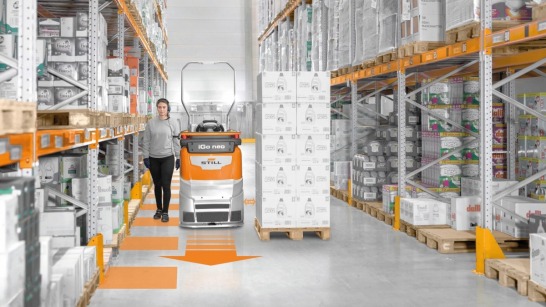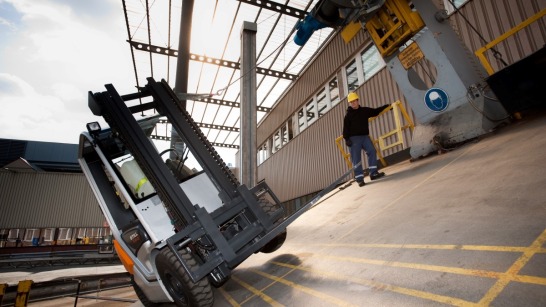Virtual Preparation, Real-World Implementation
Picture the scene: a forklift truck doing its rounds and bumping over obstacles. But this time it’s without the usual loud noises echoing around cavernous warehouses. That’s because this is a digital twin, represented by countless geometrical, virtual elements. The calculation engineers’ screens show a simulation of a physical testing procedure, in which forklift trucks navigate obstacles on a virtual test track. During the test process, the program reads forces that could only be captured in reality using expensive physical sensors. This includes data relating to critical connection points between individual components. Virtual testing provides transparency where physical testing may not be able to.
However, transparency is far from the only advantage. Mohamed Ben Ayed, Head of Calculation/Simulation at KION, produces a paper clip to demonstrate another of these advantages. He uncoils the metal wire further and further and applies force to it in various places. “The material is wearing down,” he demonstrates. How much can it withstand? In order to figure this out, in reality, in addition to material, one thing above all else is required: time. Virtual stress and lifespan calculations help here as they enable lifespan requirements for components to be checked quickly, even if, for example, the material composition is to be changed. This is because this can be achieved by changing certain parameters, instead of having to rebuild components. All this significantly shortens the development process and conserves resources.
Data Collection during the Concept Phase: the Moment of Truth
The development process relies on answering certain key questions: Will this concept work in real life? Can the materials withstand the stresses they will be exposed to? Answers to these questions are largely provided by stress and lifespan calculations. No measurement, no prototype construction—first of all, simulation engineers from STILL and Linde MH calculate the properties of the components. If their calculations and the results they provide are satisfactory, a prototype is then constructed. So, the concept phase is no longer a phase that is solely dedicated to identifying ideas: It generates valid data, which is indispensable in the development process. A good example of this is the Impact Drop Test. The picture should be familiar from part 1 of our series: extremely heavy bundles of wood are dropped onto the truck’s roof and provide clarity about the cab’s durability. However, instead of having to damage roof after roof, calculations are carried out in advance to determine the deformation of this component.
So, the job of a simulation engineer involves some detective work, i.e., finding out where the potential weak points in the materials are before they are used. This not only involves assessing external forces but also temperature distribution inside the forklift truck. CFD flow simulations are used in advance to ensure that the components do not overheat. This mainly affects ventilation within the trucks. Does the air conditioning function as it should? What temperatures occur and when? Virtual testing can provide answers to these questions.




